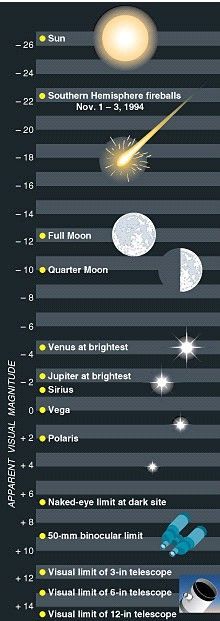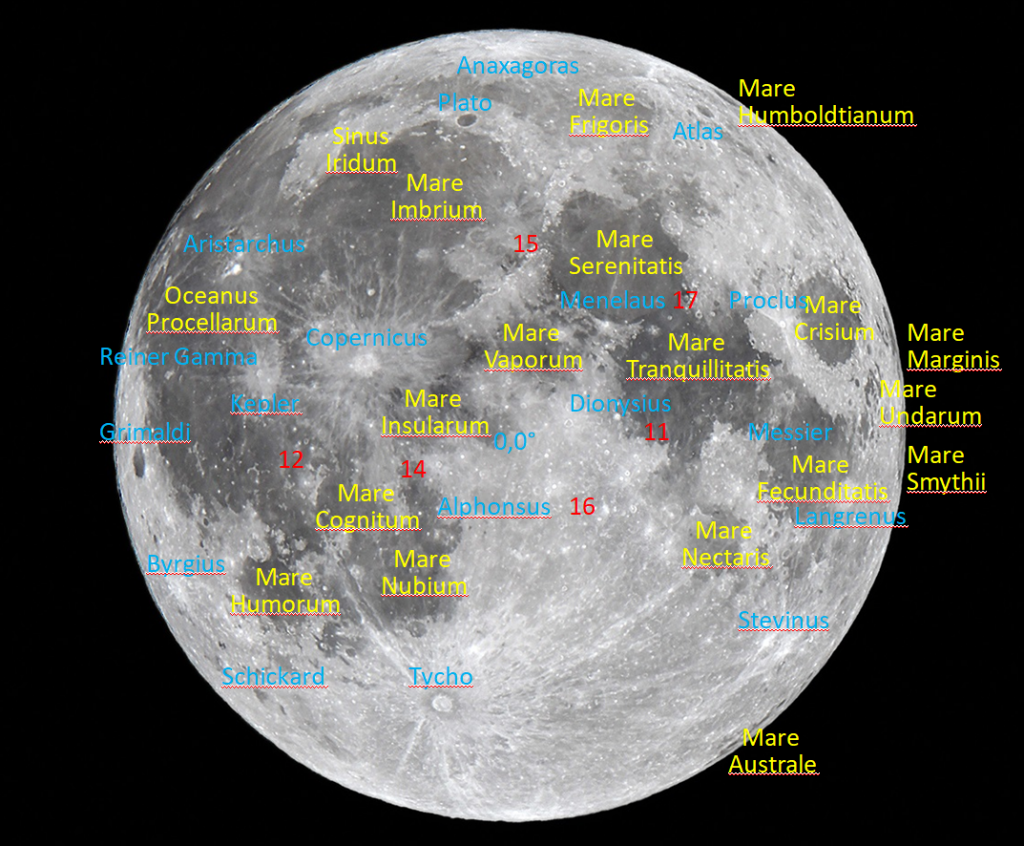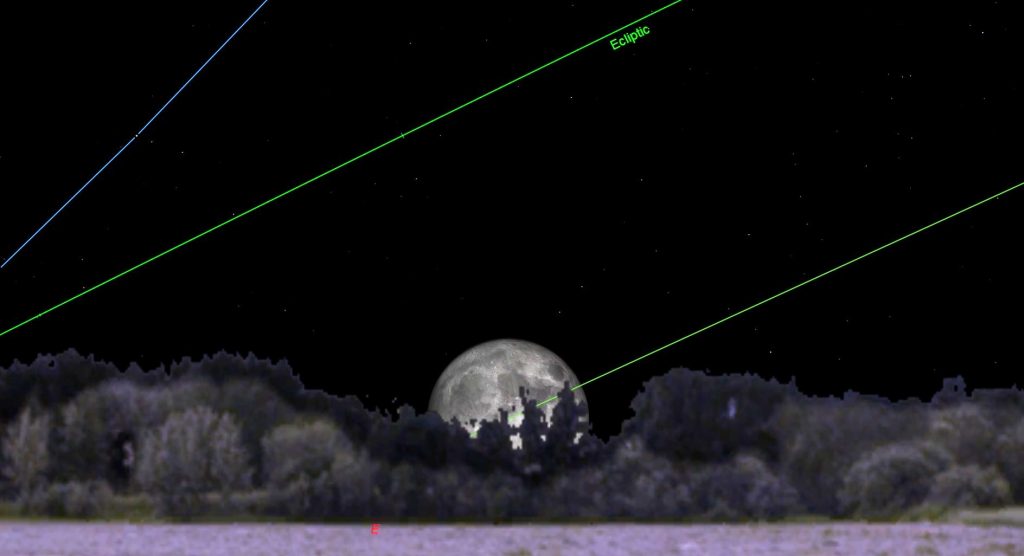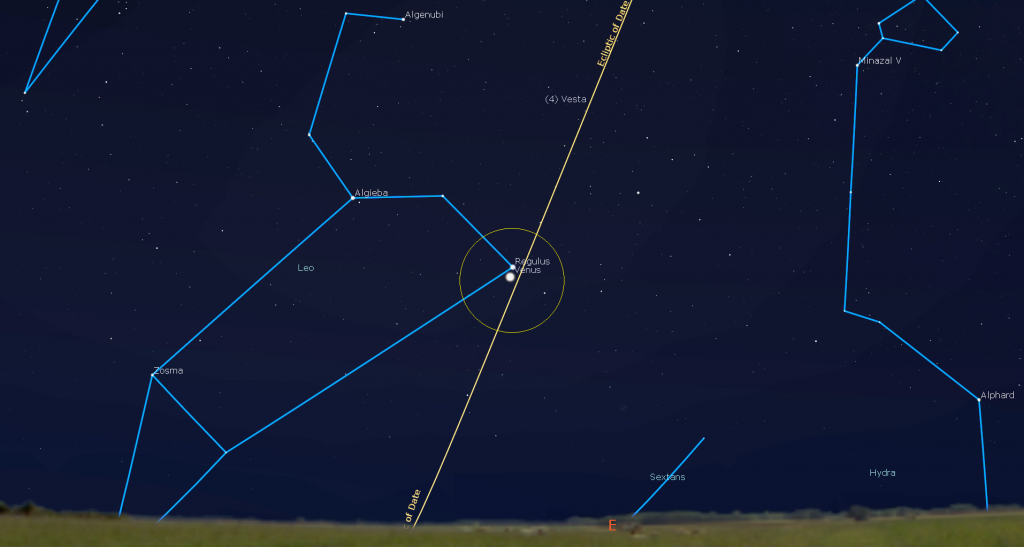The Bright Harvest Moon wades through Water Constellations, then Mambos with Mars, Venus Kisses Regulus, and Bright Baubles for Your Bubble!

This spectacular photograph of the pre-dawn zodiacal light was captured on September 25, 2020 at 5:37 am by Malcolm Park of Prince Edward County, Ontario. The bright point at centre is the planet Venus. The knot of stars above Venus is Messier 44, also known as the Beehive Cluster, in Cancer. Malcolm’s gallery of beautiful images can be viewed at https://www.photopark.ca/
Hello, End-of-September Stargazers!
Here are your Astronomy Skylights for the week of September 27th, 2020 by Chris Vaughan. Feel free to pass this along to your friends and send me your comments, questions, and suggested topics. You can also follow me on Twitter as @astrogeoguy! Unless otherwise noted, all times are expressed in Eastern Time. To subscribe to these emails please click this MailChimp link.
I can bring my Digital Starlab portable inflatable planetarium to your school or other daytime or evening event, or teach a session online. Contact me through AstroGeo.ca, and we’ll tour the Universe, or the Earth’s interior, together!
The moon, will dominate the skies around the world this week, It will rise as the full Harvest Moon for Northerners on Thursday and dance with Mars on Saturday night. I list the brightest objects in the night sky, including Mars, Jupiter, and Saturn. And gleaming Venus will kiss the bright star Regulus in the east before dawn, where you can also see the zodiacal light – if your skies are dark enough. Here are your Skylights!
Zodiacal Light
For about half an hour before dawn during the moonless periods in September and October every year, the steep morning ecliptic favors the appearance of the zodiacal light in the eastern sky, for observers in mid-northern latitudes. Zodiacal light is sunlight scattered by interplanetary particles concentrated in the plane of the solar system. It is best seen in areas free of urban light pollution.
Between now and the next full moon (on October 1), look just above the eastern horizon for a broad wedge of faint light centred on the ecliptic, which runs through Venus and the bright star Regulus in Leo (the Lion). Don’t confuse the zodiacal light with the Milky Way, which is positioned further to the southeast.
Bright Lights in the Night Sky
People often contact me to enquire about bright objects they see in the night sky- almost as if they’ve suddenly noticed Jupiter after it’s been there for months and months. But that’s okay. With the moon getting bright this week and overwhelming all the dimmer sights, I thought I’d briefly run through the brightest objects in the night sky nowadays – in decreasing order of brightness.

But first – if you see a light moving across the sky between the stars, it’s probably artificial – a satellite or an airplane. Satellites never have lights mounted on them. They shine only by reflected sunlight. For that reason, they don’t blink, or flash on and off rapidly the way aircraft do – unless they are slowly tumbling through space. The international space station (ISS) can, if the geometry with the sun is just right, outshine everything but the moon. Most of the time, however, it glides silently overhead at a brightness comparable to the brightest stars. Occasionally, one will see a very bright meteor, too.
No surprise – the moon is the brightest object in the night time sky, especially while near its full phase. Only a supernova could outshine the moon at night – if we ever got one.
The next brightest object is Venus, which is shining at magnitude -4.1 in the eastern sky between 3:45 am and sunrise every morning. The more negative the magnitude value is, the brighter the object is. And each integer difference represents a 2.5 times jump (or reduction) in brightness.
Third up is Mars. It’s the very red and bright, eye-catching object in the southeastern sky during evening. You’ll see it in the southern sky after midnight and you might also notice it low in the southwest before dawn. Last week Mars officially became brighter than Jupiter. Mars looks brighter when it’s closer to Earth and dimmer when it’s farther away. In early October, we’ll be almost as closer to Mars as we ever get. Mars will then reach a maximum brightness of -2.6, and then it will quickly start to dim as we pull ahead of (and therefore move away from) the planet on our orbital racetrack. By October 27, Mars will already be dimmer than Jupiter.
Speaking of Jupiter – it’s the very bright, creamy-white-coloured, magnitude -2.3, object shining in the southwestern sky after sunset every night. By 11 pm local time, it will be dropping towards the southwestern horizon. Jupiter, too is dimming a little every night as we move farther away from it this fall – but Jupiter’s brightness through the year doesn’t vary as much as Mars’ does.
The pre-dawn sky this month has the brightest star in the entire night sky – Sirius, in Canis Major (the Big Dog). Sirius shines at magnitude -1.45. It’s sharing the morning sky with Venus, although it is located much farther south. (There are several other very bright stars near Venus and Sirius, but we’ll skip over them until they grace our winter evening sky in the coming weeks.)
The next brightest object is the bright, orange-tinted star Arcturus. This magnitude -0.05 star will pop into view about a third of the way up the western sky after dusk, and then sink out of sight by late evening.
Up next is the bright, blue-white star Vega! Located high up the western sky in evening, Vega is part of the Summer Triangle asterism – a funny name since we can view it until late January. A long time ago Vega was chosen to anchor the magnitude scale and assigned a magnitude of 0.0. Since then, refinements in measurements have altered its value slightly to 0.03. You can see Vega descending the western sky until about 4 am local time.
The bright yellow star Capella is next in line. This magnitude 0.08 star, barely dimmer than Vega, will catch your eye as it twinkles over the northeastern horizon after 10 pm local time. Then it will climb to the top of the sky by sunrise, bringing the winter constellations with it.
Last up is Saturn. Yellow-tinted Saturn is easy to identify this year because it has been partnered with much brighter Jupiter all summer. Saturn, at magnitude 0.46, is actually 13.5 times dimmer than Jupiter. Can you detect that? Those two planets will share the summer sky of 2021, too.
Let me know how many of these bright baubles you spot – and be sure to share your knowledge with friends and family in your bubble!
The Moon
The moon will take the spotlight (well, it’ll BE the spotlight, actually) in the night sky all around the world this week. Tonight (Sunday) the moon will shine with a waxing gibbous (i.e., more than half-illuminated) phase among the relatively dim stars of Capricornus (the Sea-Goat). Last week I wrote about seeing the “Golden Handle” effect on tonight’s moon, and posted a photo here.
The moon will continue to wade through the water constellations until Saturday. From Monday to Thursday it will wax fuller and rise later while passing through Aquarius (the Water-Bearer) and then along the zone between Pisces (the Fishes) and Cetus (the Whale).

October will host two full moons this year! The first one will occur on Thursday afternoon at 5:05 pm EDT (or 21:05 Greenwich Mean Time). October full moons always shine in or near the stars of Aquarius and Pisces because those constellations are opposite the sun, which is in Virgo during October every year. Full moons always rise around sunset and set around sunrise. Because this is the closest full moon to the autumnal equinox in 2020, it is also the Harvest Moon. On the evenings around its full phase, the moon usually rises about 50 minutes later on consecutive nights. But the shallowly sloping evening ecliptic around the equinox causes Harvest Moons to rise at almost the same time each night – only delayed by as little as 10-20 minutes, depending on your latitude. (In the Toronto area, it’s 20 minutes.)
The harvest moon phenomenon traditionally allowed farmers to work into the evening under bright moonlight – hence the name. It also means that if you arrive home from work or walk the dog at the same time every evening, you might notice the “full” moon for several days in a row. The effect is stronger the farther from the equator you live. The moon behaves the same way for southern Hemisphere dwellers – only six months later, at their own autumnal equinox.

The nights around any full moon are the best ones for seeing the bright ray systems that emanate from craters on the moon. Those patterns are material that was blasted out during the impact that formed the crater. And the light and dark areas on the moon reflect the different rock types on the moon’s surface. The bright areas are the cratered lunar highlands and the dark areas are maria – iron-rich basalts that have filled the oldest deep basins.
On Friday night, the still very-full moon will land only two finger widths to the lower right (or 2.25 degrees to the celestial south) of bright red Mars. The moon and Mars will be close enough to one another to see them together in binoculars all night long. By midnight, the diurnal rotation of the sky and the moon’s eastward orbital motion will carry the moon to just a finger’s width below Mars. At sunrise on Saturday morning, Mars will sit three finger widths to the moon’s lower right in the western sky – allowing you to find the magnitude -2.52 planet with binoculars in the brightening, western sky. Early on Saturday morning, the moon will pass in front of (or occult) Mars for observers in southern and southeastern South America, most of western Antarctica, the Ascension Islands, and southwestern Africa.
The Planets
In the western sky on Thursday evening, Mercury will reach its widest separation, 26 degrees east of the Sun – or greatest eastern elongation. This would normally be the best time to see the speedy planet. But Mercury’s position well below the evening ecliptic is making this appearance of the planet a poor one for Northern Hemisphere observers – but an excellent one for observers near the equator and in the Southern Hemisphere. The optimal viewing times at mid-northern latitudes fall around 7:15 pm local time.

As soon as the sky starts to darken after sunset this week, very bright, white Jupiter will pop into view in the lower part of the southern sky. A short time after that, dimmer, yellowish Saturn will join it – sitting a generous palm’s width to Jupiter’s left (east). Our window of opportunity for clear views of those two planets is starting to close. After 11 pm local time, they will be low in the southwestern sky, and seen through a much thicker blanket of Earth’s atmosphere. Thankfully, the earlier sunsets are providing us more viewing time.
Good binoculars will reveal Jupiter’s four large Galilean moons named Io, Europa, Ganymede, and Callisto as they dance around the planet from night to night. Even a modest-sized telescope will show Jupiter’s brown equatorial belts and the famous Great Red Spot (or GRS, for short) – if the air is steady. Due to Jupiter’s 10-hour period of rotation, the GRS will appear every second or third night at your location on Earth. In the Eastern Time zone, the Great Red Spot will be crossing the planet’s disk after dusk tonight (Sunday), Friday, and next Sunday. It will be visible in late evening on Tuesday.
From time to time, the round, black shadows cast onto Jupiter by its Galilean moons are visible in amateur telescopes as they cross (or transit) the planet’s disk for a few hours. On Wednesday, September 30 from 9:04 pm EDT until Jupiter sets, Callisto’s shadow will be traveling across Jupiter. On Thursday, October 1, Io’s shadow will do the same from 7:06 pm to 9:24 pm EDT. These events will be visible anywhere on Earth where Jupiter is above the horizon during those time windows (adjusted to your local time zone). Other places will see different transits.

Saturn is a spectacular sight in any backyard telescope. Even a small one will show you Saturn’s rings. In a telescope, the rings are almost as almost as wide as Jupiter’s disk. See if you can see the Cassini Division. It’s the narrow, dark gap that separates Saturn’s main inner ring from its outer one. On Tuesday, Earth’s faster orbit will cause Saturn to appear to stop moving with respect to the distant stars. The temporary pause in motion marks the end of a westward retrograde loop that began on May 11. From now until December 21, Jupiter will chase and then catch slower-moving Saturn!
Your telescope should also reveal several of Saturn’s moons – especially its largest, brightest moon, Titan! Because Saturn’s axis of rotation is tipped about 27° from vertical (a bit more than Earth’s axis), we are seeing the top surface of its rings – and its moons can arrange themselves above, below, or to either side of the planet. During evening this week, Titan will migrate counter-clockwise around Saturn, moving from the right of Saturn tonight (Sunday) to the upper left of the planet next Sunday. (Remember that your telescope might flip the view around.) Fun fact: There’s a Lake Ontario on Titan!
Reddish Mars will continue to increase in disk size and brightness until the night of October 5-6, when Earth will be closer to Mars than at any time until 2035! Starting now, try to see the lighter and darker patches of Mars’ surface features, and its bright, little southern polar cap. (Your telescope will probably flip Mars upside-down and/or mirror it left-right).
This week, the Red Planet will be rising in the east after about 7:45 pm in your local time zone. It will climb to half-way up the southern sky at about 2 am local time, and then set in the west after sunrise. Mars is moving retrograde now, causing the planet to appear to travel backwards compared to the stars beyond it. This week, Mars will be passing out of the narrow “V” of modest stars at the bottom of the constellation of Pisces (the Fishes). Check it out!

This week’s moon-filled sky will be less than ideal for looking for the ice giant planets. Blue-green Uranus will cross the sky all night among the stars of southern Aries (the Ram). It is located a fist’s diameter below and between Aries’ two brightest stars Hamal and Sheratan, and 1.4 fist diameters to the lower left (or 14° to the celestial east) of much brighter Mars.
Neptune is located among the stars of northeastern Aquarius (the Water-Bearer), about two degrees to the left (or celestial east) of the medium-bright star Phi Aquarii or (φ) Aqr. This week, Neptune will already be in the lower southeastern sky after dusk. Then it will climb higher until midnight local time, when you’ll get your clearest view of it while it’s halfway up the southern sky.
Venus has been gleaming in the eastern pre-dawn sky for some time now. It will rise at about 3:45 am local time this week, and then remain visible in the eastern sky until sunrise while it is carried higher by the rotation of the Earth. Viewed in a backyard telescope, Venus will show a gibbous, half-illuminated shape. This week, the planet will be passing through Leo (the Lion). On Friday it will be positioned less than a finger’s width above (or 41 arc-minutes to the celestial west of) the bright, white star Regulus. The planet and star will appear together in the field of view of binoculars, or in a backyard telescope at high magnification. At closest approach, at 23:00 GMT, observers in western Asia can see Venus only 5 arc-minutes from the star. (That’s close!) On the following morning, Venus’ orbital motion eastward will lower it to a half finger’s width below Regulus.

Venus is shifting towards the sun – but the later sunrises at this time of year will let it shine in a dark, pre-dawn sky until early December! And while you’re up early, enjoy a view of the extremely bright star Sirius, and the winter constellation of Orion (the Hunter) sitting well off to Venus’ upper right.
Public Astro-Themed Events
On Monday evening, September 21 from 7 to 10 pm EDT, Ingenium – Canada’s Museums of Science and Innovation / Institute of Indigenous Research and Studies and University of Ottawa will host a free online Indigenous Star Knowledge Symposium. Details and registration are here.
Every Monday evening, York University’s Allan I. Carswell Observatory runs an online star party – broadcasting views from four telescopes/cameras, answering viewer questions, and taking requests! Details are here. Their in-person Wednesday night viewing has been converted to online via the observatory Youtube channel, where they offer free online viewing through their rooftop telescopes, including their new 1-metre telescope! Details are here.
My free, family-friendly Insider’s Guide to the Galaxy webcasts with Jenna Hinds of RASC National will return on Tuesday, October 6, when we’ll celebrate Mars’ closest approach to Earth until 2035! Details and the schedule are here and here. In the meantime, join Jenna and John Reid on alternate Thursdays at 3:30 pm EDT as they progress through the RASC’s Explore the Universe certificate program.
On Wednesday evening, September 30 at 7:30 pm EDT, the RASC Toronto Centre will live stream their monthly Speakers Night meeting. This meeting will feature PhD Candidate Alysa Obertas, David A Dunlap Department of Astronomy & Astrophysics, Canadian Institute for Theoretical Astrophysics, University of Toronto. Her talk, entitled How to Destroy a Planet, will address some of the destructive phenomena known to astronomers. Everyone is invited to watch the presentation live on the RASC Toronto Centre YouTube channel. Details are here. The RASC Toronto Centre has an archive of their past meetings and guest lectures on their YouTube Channel here.
On Wednesday evening, September 30 at 6 pm EDT, U of T’s Astronomy & Space Exploration Society (ASX) will host a free public Zoom broadcast called Hands-On Astronomy: Building Instruments to Measure Our Cosmos. Details and the Zoom link are here.
Our David Dunlap Observatory Saturday night events may be cancelled, but we’re still pleased to offer the next best thing – free online talks! On Saturday, October 3 at 7 pm EDT, join us for DDO Astronomy Night: The Stars Belong to Everyone: Fostering Diversity and Inclusion in Astronomy – a panel discussing how to expand diversity and inclusion in astronomy. More information can be found here.
The Canadian organization Discover the Universe is offering astronomy broadcasts via their website here, and their YouTube channel here.
On many evenings, the University of Toronto’s Dunlap Institute is delivering live broadcasts. The streams can be watched live, or later on their YouTube channel here.
The Perimeter Institute in Waterloo, Ontario has a library of videos from their past public lectures. Their Lectures on Demand page is here.
Keep looking up, and enjoy the sky when you do. I love questions and requests. Send me some!